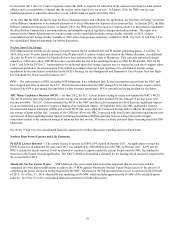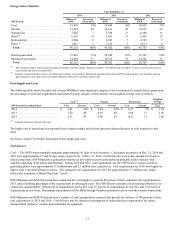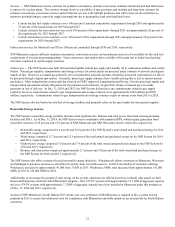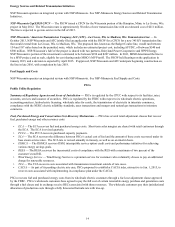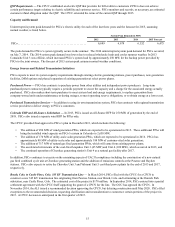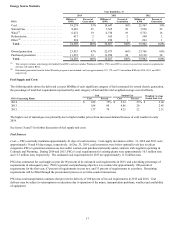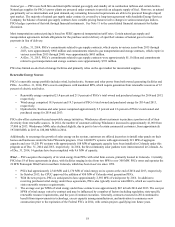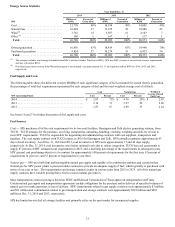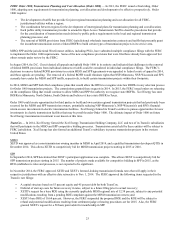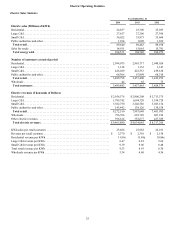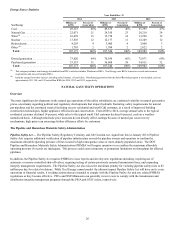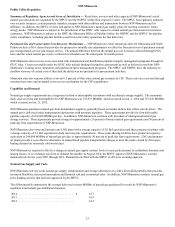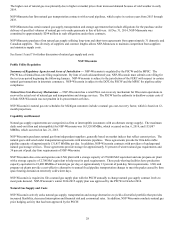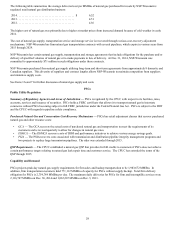Xcel Energy 2014 Annual Report Download - page 38
Download and view the complete annual report
Please find page 38 of the 2014 Xcel Energy annual report below. You can navigate through the pages in the report by either clicking on the pages listed below, or by using the keyword search tool below to find specific information within the annual report.
20
The peak demand for the SPS system typically occurs in the summer. The 2014 uninterrupted system peak demand for SPS occurred
on Aug. 7, 2014. The 2014 peak demand decreased due to cooler summer weather.
Energy Sources and Related Transmission Initiatives
SPS expects to use existing electric generating stations, power purchases, DSM and new generation options to meet its net dependable
system capacity requirements.
Purchased Power — SPS has contracts to purchase power from other utilities and independent power producers. Long-term
purchased power contracts typically require a periodic payment to secure the capacity and a charge for the associated energy actually
purchased. SPS also makes short-term purchases to meet system load and energy requirements, to replace generation from company-
owned units under maintenance or during outages, to meet operating reserve obligations or to obtain energy at a lower cost.
Purchased Transmission Services — SPS has contractual arrangements with SPP and regional transmission service providers,
including PSCo, to deliver power and energy to its native load customers, which are retail and wholesale load obligations with terms
of more than one year.
SPP Integrated Market (IM) — In February 2014, the FERC granted SPS approval to make sales to the SPP IM at market-based
rates. Further, In February and March, respectively, SPS was granted interim approval for revised QF tariff pricing in Texas and New
Mexico to be consistent with the new market and to coincide with the start of the IM. The SPP IM began operations in March 2014
and operates in the day ahead and real time energy and ancillary services market. In April 2014, the FERC approved SPS’ filings to
modify its wholesale power sales contracts to allow recovery of SPP IM charges and revenues through the SPP wholesale FCA.
SPS Transmission NTCs — As a member of SPP, SPS accepts NTCs for electric transmission line and substation projects to be built
within the SPP footprint. SPS has accepted NTCs for projects with an estimated capital cost of approximately $1.9 billion and will
continue to review new NTCs for acceptance as they are issued. These projects generally span several years to plan, site, procure and
develop. The NMPRC and the PUCT must approve the siting and routing of any SPP identified transmission line NTC projects that
require permitting approval. Projects identified through SPP NTCs may have costs allocated to other SPP members in accordance
with the SPP OATT. Costs allocated to SPS are permissible for recovery through the NMPRC, the PUCT and the FERC processes.
High Priority Incremental Load Study Report
In April 2014, the SPP Board of Directors approved the High Priority Incremental Load Study Report, a reliability assessment that
evaluated the anticipated transmission needs of certain parts of the SPP resulting from expected load growth in the area. As a result of
this study, SPS has received NTCs and conditional NTCs for 44 new transmission projects to be placed into service by 2020. SPS is
developing plans for these projects in preparation of submitting CCNs to the PUCT and the NMPRC. These projects are intended to
provide regional reliability benefits as well as the ability to serve the increase in load in southeastern New Mexico.
TUCO substation to Woodward, Okla. 345 KV transmission line
The TUCO to Woodward District extra high voltage interchange is a 345 KV transmission line. SPS constructed the line to just inside
the Oklahoma state line, and Oklahoma Gas and Electric Company (OGE) built from there to Woodward, Okla. SPS’ investment in
the TUCO to Woodward line and substation is approximately $206 million and is expected to be recovered from SPP members,
including SPS, in accordance with the SPP tariff. The line was placed into service in September 2014.
Hitchland substation to Woodward, Okla. 345 KV transmission line
The Hitchland substation to Woodward, Okla. line is a 345 KV double circuit transmission line and associated substation facilities in
the Oklahoma and Texas Panhandle. SPS built the first 30 miles to Beaver County, Okla. and OGE completed the line from there to
Woodward, Okla. SPS’ investment for the Hitchland to Woodward line and substation is approximately $58 million and is expected to
be recovered from SPP members in accordance with the SPP tariff. The line was placed into service in May 2014.
Potash Junction substation to Roadrunner substation 345 KV transmission line
In April 2014, SPS filed a CCN with the NMPRC for a new 345 KV transmission line from the Potash Junction substation to the
Roadrunner substation, both near Carlsbad, N.M. The proposed line would run 40 miles and cost an estimated $54 million. The
NMPRC approved the CCN in December 2014. The line is anticipated to be placed into service in the fourth quarter of 2015.
SPS Resource Plans — SPS is required to develop and implement a renewable portfolio plan in which 15 percent of its energy to
serve its New Mexico retail customers is produced by renewable resources in 2015. SPS primarily fulfills its renewable portfolio
requirements through PPAs.


